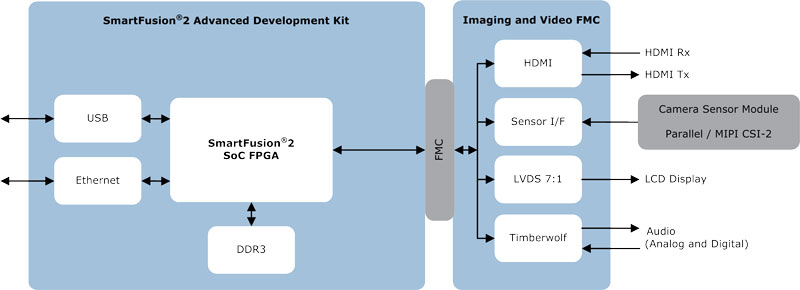New FMC-based daughter card and IP supports image sensors
Microsemi Corporation has announced new additions to its imaging/video solution supporting the popular Mobile Industry Processor Interface (MIPI) camera serial interface (CSI-2). The enhancements, including a new field programmable gate array (FPGA) mezzanine card (FMC)-based daughter card and new intellectual property (IP) which support image sensors with MIPI CSI-2 interfaces, enable customers to use the company’s power-efficient, highly secure IGLOO2 FPGA and SmartFusion2 system-on-chip (SoC) FPGA capabilities in CSI-2-based camera systems.
As a standard specification by the MIPI Alliance, MIPI CSI-2 defines an interface between a peripheral device such as an image sensor and a host processor such as a baseband or application processor.
Microsemi’s imaging and video solution is comprised of an imaging/video IP suite and FMC daughter card for MIPI CSI-2 sensor interface. Users can instantiate the MIPI CSI-2 IP in the SmartFusion2 or IGLOO2 FPGA designs and then implement image processing and bridging to other interfaces or peripherals. By leveraging Microsemi’s power-efficient FPGAs in the designs of CSI-2 cameras, users could potentially lower system costs or use smaller, longer lasting batteries while benefitting further by using the most secure FPGAs to protect their IP.
“Our CSI-2 FMC daughter board bundled with our IP enables customers to quickly design a wide variety of imaging solutions. In addition, the low power of our IGLOO2 and SmartFusion2 FPGAs are particularly compelling for camera designs which are often size and power constrained,” said Ted Marena, director FPGA marketing at Microsemi. “We are excited to continue growing our imaging and video offering, which allows us to expand our customer base for those designing with CSI-2 cameras across various applications, particularly those requiring high security and low power—two areas in which we excel.”
Microsemi’s newly enhanced MIPI CSI-2 imaging/video solution includes an FMC-based daughter card with an image sensor module which works with Microsemi’s SmartFusion2 advanced development kit. The MIPI CSI-2 receiver decoder IP is supported in SmartFusion2 and IGLOO2 FPGAs. It comes with a MIPI CSI-2 reference design project and a graphical user interface (GUI) software for real-time video demonstration configuration. The company also expects future enhancements to its CSI-2 IP and FMC daughter card to also support its recently launched cost-optimised, low power PolarFire mid-range FPGAs.

The MIPI CSI-2 receiver decoder IP supports multi-lane (one, two and four lanes), RAW8 (eight bit data width), and both short packet and long packet formats for transporting image data. As use of the MIPI CSI-2 standard continues to expand within numerous types of image sensors, the new enhancements to Microsemi’s imaging/video solution extend its ability to cater to the market’s increasing opportunities. Designs can be easily reused across multiple platforms using Libero SoC Design Suite, a comprehensive, easy to learn, easy to adopt development toolset for designing with Microsemi's power-efficient FPGAs and SoC FPGAs.
In addition to speeding the adoption of Microsemi FPGA technology in MIPI CSI-2 camera designs, the new solution adds to the company’s growing portfolio of solutions for video and imaging applications which are differentiated from competitors with the company’s expertise in low power, reliability and security. Designers can leverage the solution for numerous applications across industrial, defence, medical, aviation and automotive markets, including machine vision cameras; thermal, infrared and night vision cameras; hand-held cameras and medical imaging. In applications such as thermal imaging, Microsemi’s low power dissipation can provide advantages over competing FPGAs and digital signal processors (DSPs).
“The overall infrared and thermal imaging market is growing at a rate of 6.5% and is likely to reach $23.25bn by 2023,” said Dependra Lall, senior analyst, IndustryArc. “The declining prices of infrared imaging and the advantages offered by uncooled infrared imaging applications, such as advanced driver assistance systems in automotive and infrared detectors in industrial and security, are set to drive the growth of this segment.”











